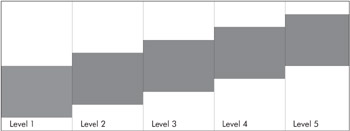The Adaptive Goal and Core Objectives
The arc and progression to Russian Squares is one of growing intensity. However, it is not a straight linear growth of intensity through the levels. Each level begins calm and ends frantic, relatively speaking, but each successive level begins and ends slightly more intense than the last.

Figure 15-1: Intensity Range
Our first objective for the adaptive score was to mirror the progression of game levels. This approach involved creating a score that increased in intensity from the start to the end of each level (microadaptability), while each successive level began at a higher intensity than the last (macro-adaptability). Within the game levels, we focus on the primary gameplay element of clearing rows. A musical change occurs each time the player clears a row, a reward that lets the player know he is on the right track. In addition, the change indicates the growing intensity as the rows clear. Running out of time and having a row added is the negative counterpart to clearing a row. The score reflects this state as well.
Russian Squares uses an additive-subtractive approach to the music, in which the music engine can add or peel away instrument layers. Given that the time it takes to clear a row can be anywhere from a few seconds to a few minutes, this is a very practical solution. It allows for musical development while maintaining direction and momentum. Implementing this technique has some complications, however. In terms of aesthetics, simply moving along a linear curve from low intensity to high intensity does not work, as adding layer after layer and increasing the tempo is not very musical. The music requires larger sections, instrumentation changes, rhythmic shifts, and tonal changes to stay interesting. In this way, the music progresses in a multidimensional manner. This concept is the backbone for the adaptive audio design of Russian Squares.
We mirror many other gameplay elements with musical gestures. Most of these are musical accents indicating important events as they occur in the game. DirectMusic motifs layer these accents over the main body of music. These motifs include row clear, row add, blocker, time running low, high score, and active square. We also use musical gestures for start game, end game, and pause game.
Another objective is creating three compositions that share the same core functionality. Three differing pieces of music react in the same manner to the gameplay, and their common adaptive framework allows them to be interchangeable. Having multiple compositions underscores the need to establish a solid adaptive framework prior to composing. Using quality instrument samples goes beyond aesthetics. Sounds also need to be flexible in an adaptive score. DLS instruments offer this flexibility because single note samples can react more quickly than prerecorded phrases.
Inherent Obstacles
The biggest trick was creating a score that could gradually increase or decrease in intensity at any time while creating a satisfying musical experience. How could we put such a score together? How would the layers function? How would transitions operate? The overall objective seemed simple enough, but just thinking about execution for a few moments brought up all kinds of tough questions. Moreover, digging into the production of the score unearthed many more!
The music in Russian Squares needs to change quickly. Consider that it may take the player a minute or two to clear a row at the start of the game, yet toward the end of any level, the player can clear a row or the game can add one every few seconds. This poses a curious problem. If music changes every minute or so, you should use longer sections to better hold the listener's interest and avoid repetition. However, when the music changes every few seconds, it must not disrupt the aesthetic flow of the phrases. A successful adaptive score strikes a balance between the length of phrases, their transition boundaries, and the music's responsiveness to game changes.
In the modern electronica genre, nothing can make the music cheesier than wimpy sounds. Electronica lives and dies by its grooves, fat synthesizer patches, and filter sweeps. It depends heavily on timbres. This demand for great sounds creates a challenge for the audio producer facing severe memory constraints.
The last challenge we needed to overcome was repetition. Any game composer understands the challenge of avoiding undue repetition in game scores. Russian Squares was no exception. A player can easily spend a lot of time solving a given level. As the difficulty rises, rows are cleared, added, cleared, and added again, triggering the same music cells. Luckily, DirectMusic offered us many ways to deal with this and the rest of the challenges we faced during production of our adaptive score.
EAN: 2147483647
Pages: 170